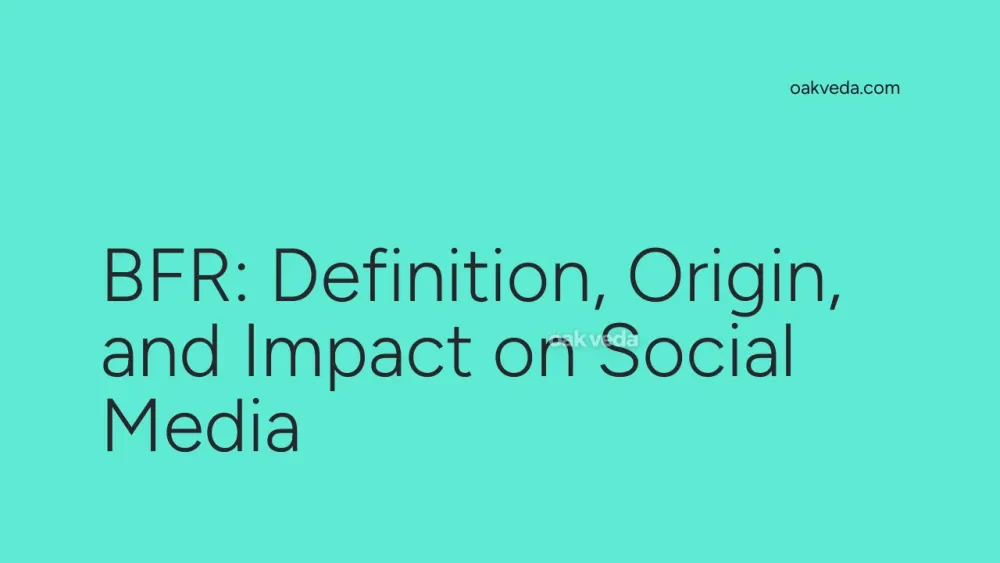
What is BFR?
BFR, an acronym for "Be For Real," is a popular social media term used to express disbelief, skepticism, or outrage towards a particular statement or situation. This shorthand phrase has become increasingly common in online conversations, allowing users to quickly convey their doubts or surprise about the credibility of information shared on various platforms.
Origin and Development of BFR
The term BFR originates from African American Vernacular English (AAVE) and has since gained widespread popularity across social media platforms. Its usage has evolved from casual conversations to become a staple in online communication, particularly among younger generations. The acronym's simplicity and versatility have contributed to its rapid adoption and integration into digital slang.
How BFR Works
When someone uses BFR in a social media context, they are typically responding to content they find hard to believe or accept. The acronym serves several purposes:
- Expressing skepticism: Users employ BFR to question the truthfulness or authenticity of information.
- Conveying surprise: It's used to react to statements or situations that seem outrageous or unexpected.
- Adding sarcasm: BFR can inject a touch of sarcasm into responses, highlighting the perceived absurdity of a claim.
By using BFR, social media users can efficiently participate in online discussions and share their reactions without writing lengthy responses.
Types or Variations of BFR
While BFR is widely recognized, there are variations of the term that have emerged:
- BFFR: Standing for "Be Fucking For Real," this more emphatic version is used when expressing stronger disbelief or frustration.
- BFR?: Sometimes used with a question mark to directly challenge the validity of a statement.
Popular Examples of BFR
To better understand how BFR is used in social media conversations, consider these examples:
- In response to an unlikely claim: "My friend says he can eat 50 hot dogs in one sitting. BFR, that's impossible!"
- Reacting to surprising news: "Did you hear? They're canceling all student debt! BFR?"
- Expressing outrage: "The company raised prices by 200% overnight. BFR, they're just exploiting customers!"
Impact of BFR on Social Media Culture
The widespread use of BFR has significantly influenced social media culture in several ways:
- Concise communication: BFR allows users to express complex emotions and reactions quickly, fitting well with the fast-paced nature of social media.
- Community building: The use of shared slang like BFR helps create a sense of belonging among social media users, particularly within younger demographics.
- Tone indication: In text-based communication, BFR serves as a clear indicator of the user's tone, helping to prevent misunderstandings.
- Meme culture: The term has become part of meme culture, often used in image macros and reaction GIFs to express disbelief humorously.
Controversies or Debates Surrounding BFR
While BFR is widely used, it's not without its controversies:
- Appropriation concerns: As BFR originates from AAVE, there are ongoing discussions about cultural appropriation when used by non-Black individuals.
- Generational divide: Older social media users may find the term confusing or inappropriate, leading to potential misunderstandings.
- Overuse: Some argue that the frequent use of acronyms like BFR oversimplifies communication and reduces the nuance in online discussions.
How Brands and Influencers Use BFR
Savvy brands and influencers have incorporated BFR into their social media strategies:
- Engagement: Using BFR in posts or comments to connect with younger audiences and appear more relatable.
- Marketing campaigns: Creating content that plays on the concept of disbelief, encouraging users to respond with BFR.
- Product launches: Teasing new products or features with claims so impressive that they prompt BFR responses, generating buzz.
Future Trends Related to BFR
As social media continues to evolve, so too will the use of terms like BFR:
- Integration into AI: Chatbots and AI assistants may incorporate BFR to create more natural, human-like interactions.
- Evolution of meaning: The term may take on new connotations or uses as language continues to change rapidly online.
- Cross-platform usage: BFR may become more prevalent across various social media platforms, including professional networks.
FAQs about BFR
-
Is BFR considered formal language? No, BFR is informal slang primarily used in casual online conversations.
-
Can BFR be used in professional settings? It's generally not appropriate for formal or professional communication.
-
How do you pronounce BFR? It's typically spelled out as "B-F-R" or said as "Be For Real."
-
Is BFR specific to any particular social media platform? While popular on platforms like Twitter and TikTok, BFR is used across various social media sites.
-
Are there any alternatives to using BFR? Yes, phrases like "Seriously?" or "Are you kidding me?" convey similar sentiments in a more formal manner.
In conclusion, BFR has become an integral part of social media language, offering users a quick and expressive way to convey disbelief or skepticism. As online communication continues to evolve, understanding and appropriately using terms like BFR can help individuals navigate the complex landscape of digital interactions more effectively.
You may be interested in:
- TBF: Definition, Origin, and Impact on Social Media
- GRWM: Definition, Origin, and Impact on Social Media
- Tea: Definition, Origin, and Impact in Social Media Culture
- Trending: Definition, Origin, and Impact on Social Media
- Social Sets: Definition, Origin, and Impact on Social Media Management
- 1437: Definition, Origin, and Impact on Social Media

